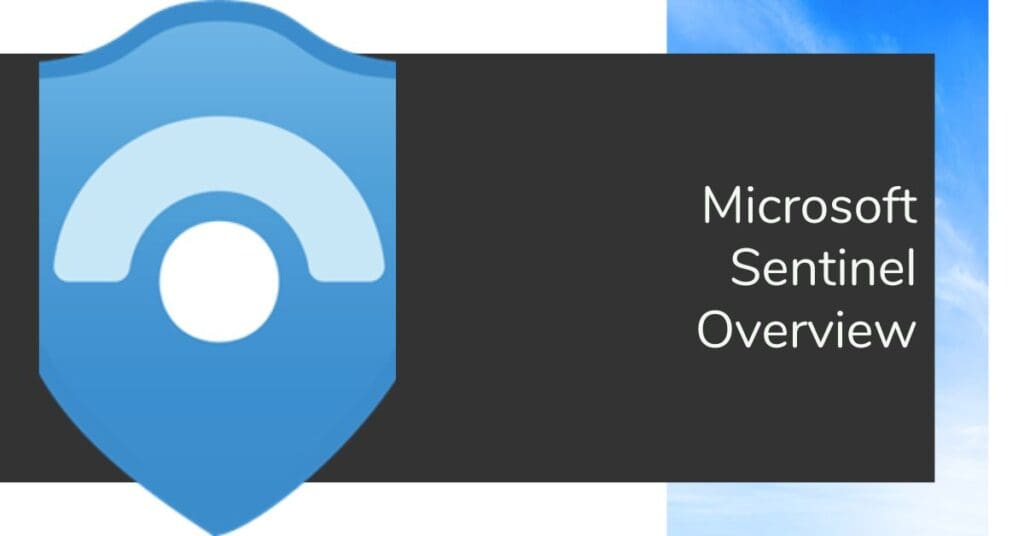Microsoft Sentinel Overview

If you’ve made it to this blog, it’s clear you’re invested in your company’s cybersecurity initiatives. As cyber threats evolve in sophistication, having a robust security solution could be the difference between staying afloat or drowning from a cyberattack. Enter Microsoft Sentinel, a platform designed to tackle modern security challenges head-on.
According to Microsoft, “Sentinel delivers intelligent security analytics and threat intelligence across the enterprise. With Microsoft Sentinel, you get a single solution for attack detection, threat visibility, proactive hunting and threat response.”
So, what does this mean for you and your organization? How can you implement this tool to better combat cybercriminals? As a proud Microsoft Tier 1 Cloud Solution Provider (CSP), we’re happy to guide you through commonly asked questions and help you determine if Sentinel is right for your company.
What is Microsoft Sentinel for?
Microsoft Sentinel, much like a managed service provider, serves as a proactive guardian for your organization’s digital assets, offering a holistic approach to security management. As a SIEM (security information and event management) solution, it aggregates and analyzes vast amounts of data from diverse sources, providing valuable insights into potential threats and vulnerabilities. Additionally, its SOAR (security orchestration, automation and response) capabilities enable seamless automation of routine security tasks, freeing up valuable resources and accelerating incident response times.
Sentinel goes beyond traditional security tools by harnessing the power of artificial intelligence and machine learning. These technologies empower organizations to detect anomalies, identify patterns and predict potential security incidents before they escalate.
Continuously learning and adapting to evolving threats allows Sentinel to provide a proactive defense mechanism against emerging cyber risks.
Moreover, Microsoft Sentinel’s cloud-native architecture ensures scalability and flexibility, allowing organizations to adapt to changing security requirements seamlessly. Whether you’re a small business or a large enterprise, Sentinel offers tailored solutions to meet your unique security needs, providing peace of mind.
What is the function of Microsoft Sentinel?
Sentinel offers a multifaceted approach to threat detection and response. By harnessing the power of cloud-scale data collection, organizations can gain deep insights into their security posture across diverse environments.
This includes not only on-premises infrastructure but also cloud-based applications and services, ensuring comprehensive coverage.
Sentinel’s advanced analytics and threat intelligence capabilities provide organizations with the tools needed to stay one step ahead of cyber threats. By leveraging machine learning algorithms and real-time monitoring, Sentinel can identify and mitigate previously undetected threats while minimizing false positives. This proactive approach to threat detection helps organizations strengthen their defenses and protect against emerging cyber risks.
The software empowers security teams to conduct thorough investigations with intelligence-driven insights. By tapping into years of cybersecurity expertise from Microsoft, organizations can leverage artificial intelligence to analyze security incidents at scale.
These insights accelerate the investigation process and enable security teams to uncover hidden threats and vulnerabilities before they escalate into major incidents.
Finally, Microsoft Sentinel streamlines incident response with built-in orchestration and automation capabilities. By automating routine security tasks and workflows, Sentinel enables security teams to respond rapidly to security incidents, reducing the time to resolution and minimizing the impact on the organization.
With this proactive approach to incident response, organizations can effectively mitigate security threats and protect their digital assets.
What is the difference between Microsoft Defender and Sentinel?
While Microsoft Defender specializes in safeguarding endpoints from malicious threats, Microsoft Sentinel takes a more comprehensive approach to security by extending its capabilities across the entire enterprise. Defender focuses on endpoint protection; Sentinel acts as the central nervous system of your organization’s security operations, providing real-time monitoring, threat detection and incident response capabilities across all layers of the IT infrastructure.
Together, both solutions play vital roles in the security ecosystem. Sentinel integrates seamlessly with various Microsoft Defender products, such as Microsoft Defender for Endpoint and Microsoft Defender for Cloud Apps, to provide a unified defense strategy.
Additionally, Sentinel’s compatibility with third-party security tools ensures interoperability and flexibility, allowing organizations to leverage their existing investments while augmenting their security posture.
Is Microsoft Sentinel an SIEM or a SOAR?
Microsoft Sentinel blurs the lines between SIEM and SOAR, offering the best of both worlds. As an SIEM, it provides comprehensive event logging, correlation and analysis capabilities. Simultaneously, its SOAR functionalities enable automated response actions, playbook orchestration and workflow automation.
This unique combination makes Microsoft Sentinel a versatile tool for modern security operations that enables digital transformation.
Main Takeaways
We’ve just thrown a lot of information at you. Confused? You don’t have to be.
Here are the four main takeaways from this blog post on what Sentinel is and what it can offer your organization:
- Comprehensive security management: Microsoft Sentinel offers a holistic approach to security management, combining SIEM and SOAR capabilities
- Advanced analytics and automation: With artificial intelligence and machine learning, Sentinel detects threats proactively and streamlines incident response through automation
- Scalable and flexible: Its cloud-native architecture ensures scalability and flexibility, catering to organizations of all sizes and environments
- Integration with Microsoft Defender: Sentinel seamlessly integrates with Microsoft Defender products, extending its capabilities across the entire enterprise for a unified defense strategy
Ensure a Successful Sentinel Implementation
As you’ve likely gathered by now, Sentinel is a strategic asset in your cybersecurity arsenal. The only question is, are you ready to take your security operations to the next level?
Contact us or book a meeting today to experience the peace of mind that comes with proactive threat detection and response from Microsoft Sentinel.
